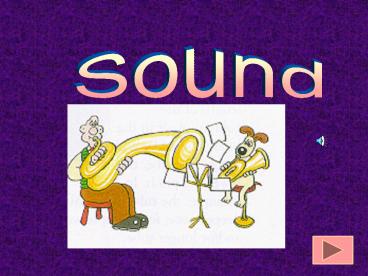Sound - PowerPoint PPT Presentation
1 / 22
Title:
Sound
Description:
Sound Waves are caused by a source vibrating to and fro and causing successive ... www.howstuffworks.com/cassette.htm. Short BrainPop movie about CDs and DVDs ... – PowerPoint PPT presentation
Number of Views:92
Avg rating:3.0/5.0
Title: Sound
1
Sound
2
What is SOUND?
Sound is longitudinal pressure waves that travel
through elastic media.
3
- We can produce these vibrations by
- Making a column of air vibrate,
- plucking a string, or
- by hitting an object
4
Sound Waves
Sound Waves are caused by a source vibrating to
and fro and causing successive compressions
(squashing) and rarefactions (spreading out) in
the medium hence sound cannot travel in a
vacuum. Sound waves are received by the ear, and
interpreted by the brain.
5
Sound can vary in pitch how high or low a note
is. It can also vary in volume how loud or how
soft the note is
6
An amplifier makes the sound louder. We talk
about the amplitude of the wave, which tells us
how much energy there is. The taller the wave the
louder the sound because more energy has been put
in
7
The loudness depends on how much energy the sound
wave has. In an electric key board an amplifier
makes the sound louder. A louder note has a
bigger amplitude. (height)
8
Loudness is measured in decibels dB
9
These help to make sound louder so the amplitude
or height of the wave would be higher. The wave
has more energy
10
The pitch depends on how many vibrations there
are. The more frequent the vibrations the higher
the note. The fewer the vibrations the lower the
note
11
The higher the note, the more waves per second so
the waves are squashed together. The waves will
have a short wave length.
12
The lower the note, the FEWER waves per second so
the waves are spread out. The waves will have a
longer wave length.
13
Different instruments produce different shaped
wave traces. The extra wiggles are known as
harmonics. These give the instrument its colour.
14
Most instruments usually produce many frequencies
or harmonics at the same time. All the harmonics
add together to make a complicated waveform.
15
Here are some synthesized wave traces each shape
represents a different kind of sound.
16
(No Transcript)
17
(No Transcript)
18
(No Transcript)
19
On the next few slides you will find internet
sites that you can visit by clicking on the web
address
http//micro.magnet.fsu.edu/electromag/java/speake
r/
http//www.brainpop.com/science/sound/sound/index.
weml
20
How Stuff Works article on CDs and CD
playerswww.howstuffworks.com/cd.htm How tape
recorders workwww.howstuffworks.com/cassette.htm
Short BrainPop movie about CDs and
DVDswww.brainpop.com/tech/musicandsound/cd/index.
weml How CDs work, with an animated
diagrammicro.magnet.fsu.edu/electromag/java/cd/
How CDs and CD players workwww.discoverengineer
ing.org/eweek/cool_things/cd/index.htm How
analogue and digital recording workswww.howstuffw
orks.com/analog-digital.htm The technology of
vinyl records compared with CDswww.pbs.org/ktca/n
ewtons/11/cdlp.html An animated look at how a
speaker worksmicro.magnet.fsu.edu/electromag/java
/speaker/
21
Watch a movie about soundwww.brainpop.com/science
/sound/sound/index.weml Take an underwater
sound quizwww.pbs.org/wgbh/nova/subsecrets/sounds
.html02 Find out why sonic booms occur, with
help from a speeding motorboatwww.howstuffworks.c
om/question73.htm How bats use
echolocationmembers.aol.com/obcbats/ecolocation.h
tml
22
(No Transcript)

